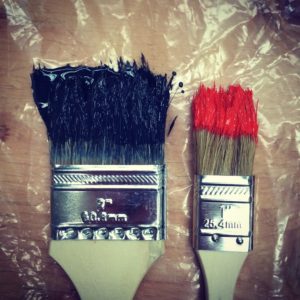So you need to paint a room… or worse, your whole house! Whether you’re getting you Nashville home ready to sell or painting a home your recently purchased, getting a lot of painting done can be incredibly daunting. Sure, you can DIY basic and small painting projects… but is it worth the hassle? Alternatively, is hiring a pro painter worth the cost? I’ll help you break it down!
Home Painting Cost Comparison
| Size | Hire a Pro Painter | DIY your Painting |
|---|---|---|
| Paint a single room | $100 – $500 | $60 – $300 |
| Paint multiple rooms | $950 – $2,400 | $600 – $1,200 |
 Consider the following when estimating how much you’ll pay for an interior painting job:
Consider the following when estimating how much you’ll pay for an interior painting job:
- Labor costs (if hiring a pro)
- Paint costs – expect to pay between $31 – $120 per gallon, depending on the type of finish and how much paint you’ll need
- Additional supplies – most painting projects will need brushes, painter’s tape, drop cloths, etc.
Exterior painting costs
There are many areas outside that you might consider repainting – siding, decking, gutters, front and back doors, etc. Some of these are quick and simple DIY jobs, like repainting your deck or front door. But it’s a good idea to consider a pro when it comes to bigger projects.
Best left to a professional painter:
- Single-story home: $1,000 – $3,000
- Two-story home: $3,000 – $4,500
- Three-story home : $4,500 – $6,000
- Stucco siding: $900 – $3,000
- Vinyl siding: $600 – $2,000
- Wood siding: $700 – $2,000
Great DIY exterior painting projects:
- Home doors: $70 – $150
- Home Gutters: $200 – $800
- Porches or decks: $500 – $2,000
- Home Window shutters: $150 – $400
Paint Types to Consider
Flat — This gives most forgiving finish with the best color payout. If you want a saturated, velvety wall, a flat finish will give you rich results. If your wall has imperfections like uneven texture, patches or joints, flat paint will absorb light and make them less noticeable. However, flat finishes are not very durable and need to be carefully cleaned. Scrubbing flat paint could wear down the finish and cause sheen to appear in patchy spots.
• Best places to use flat paint: Ceilings (which tend to have flaws), accent walls, low-traffic rooms that don’t need frequent cleaning.
Low-Luster — Many consider eggshell or satin finishes to be the best compromise between pigment and strength. These finishes look matte from straight on, but viewed at an angle, they have a subtle sheen. This makes them longer-lasting, but the sheen does show imperfections, especially if your room gets direct sun, so prepping the wall and using a good primer is still necessary.
• Best places to use low-luster: Living room, bedroom, dining room.
Gloss/Semigloss — The most durable finish, it holds up well in humidity and is easy to clean, but it does reflect light, calling attention to any and all minor flaws. In order for it to look smooth and even, the surface must be perfectly prepped and the paint applied very carefully to avoid streaky, uneven sheen.
• Best places to use gloss: Bathroom, kitchen, mud room, doors, baseboards.
[showcaseidx shortcode encountered an error]
